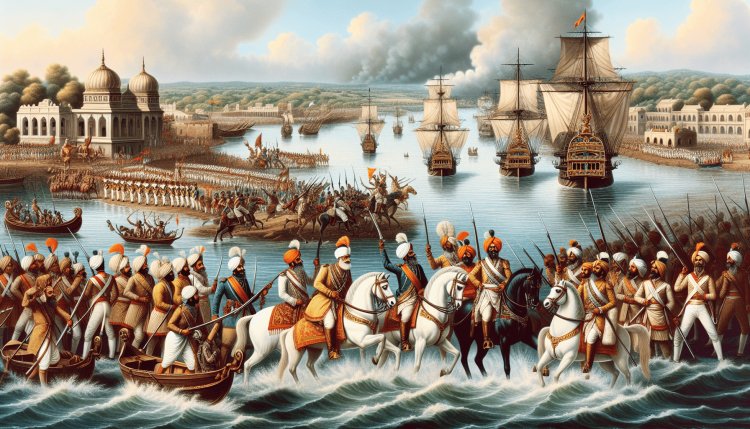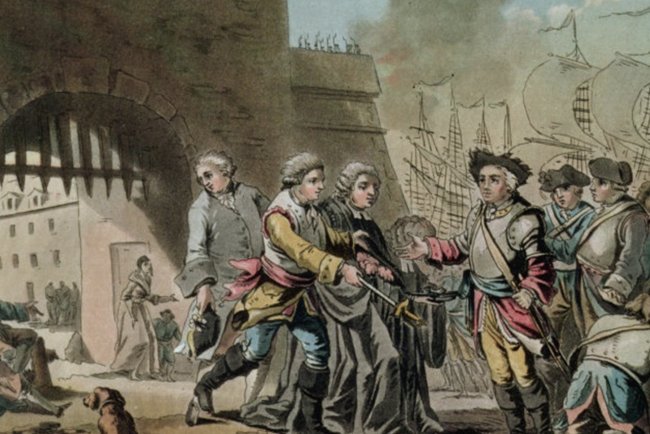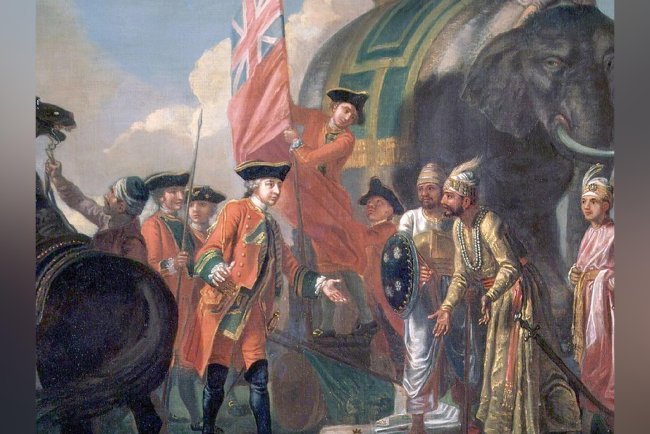Conquest of Bengal: The British Victory in Bengal
The Battle of Buxar, fought on October 22, 1764, marked a significant turning point in the history of British India. This decisive conflict saw the British East India Company, under the leadership of Major Hector Munro, defeat the combined forces of Mir Qasim, Nawab of Awadh Shuja-ud-Daula, and Mughal Emperor Shah Alam II. The battle showcased British military prowess and strategic acumen, leading to their firm control over Bengal, Bihar, and Odisha. The victory at Buxar established British supremacy in India and paved the way for their colonial expansion, altering the political landscape of the region.

The Conquest of Bengal, including the Battle of Plassey and the Battle of Buxar, marks a significant chapter in history. The Nawabs of Bengal were the rulers of Bengal, Bihar, and Odisha. In the 18th century, Bengal was a major exporter of raw materials to Europe, including saltpeter, rice, indigo, pepper, sugar, silk, and embroidery and weaving products. In the early 18th century, 60% of Britain's imports from Asia came from Bengal.
In 1700, Murshid Quli Khan was appointed the Diwan of Bengal and managed its affairs until his death in 1727. After him, his son-in-law Shuja ruled Bengal for fourteen years. Following a brief period of rule by Murshid Quli Khan's incompetent son, Alivardi Khan overthrew him and seized power, ruling until 1756. During his reign, Bengal became extremely prosperous due to various factors.
The administration of Bengal was very displeased with the special privileges granted to the English company, as it caused significant losses to the provincial treasury. This became a major point of contention between English commercial interests and the Bengal government. Between 1737 and 1765, power gradually shifted from the Nawabs of Bengal to the British.
Siraj-ud-Daulah and the British
In 1740, Alivardi Khan became the Nawab of Bengal after deposing Sarfaraz Khan. He was a capable ruler, but his entire reign was spent in wars with the Marathas. He died in 1756 without a male heir, leading to a succession crisis among his three daughters' families. Ultimately, Siraj-ud-Daulah, the grandson of his youngest daughter, became the Nawab. Siraj faced hostility from his aunt Ghaseti Begum, Rajvallabh, and Shaukat Jang, the son of another daughter, as well as increasing British insolence.
From 1757 to 1765, the history of Bengal is marked by the gradual transfer of political power from the Nawabs to the British. During this brief eight-year period, three Nawabs—Siraj-ud-Daulah, Mir Jafar, and Mir Qasim—ruled Bengal.
Enemies of Siraj
Siraj's succession was opposed by his aunt Ghaseti Begum and his cousin Shaukat Jang. A powerful faction in the Nawab's court, including Jagat Seth, Amichand, Rajvallabh, Rai Durlabh, Mir Jafar, and others, also opposed Siraj's succession. In May 1756, Siraj set out to suppress the rebellious Nawab of Purnia. However, upon learning of the British defiance and open behavior in Calcutta, he returned from Rajmahal and attacked Calcutta, capturing it. Subsequently, he launched a successful military campaign against Purnia. Shaukat Jang was defeated and killed in the Battle of Manihari in October 1756. Siraj's fortunes were at their peak, and he received a royal (Mughal) decree appointing him as the Subedar of Bengal, Bihar, and Odisha.
The British exploited Siraj's internal weaknesses. They began fortifying Calcutta, sheltered Rajvallabh's son in their fort, and misused trade permits. Siraj protested these actions to the British. However, emboldened by their success against the French in South India, the British ignored Siraj's orders. Siraj declared war against the British, first capturing Kasimbazar and then Fort William on June 20, 1756. The British took refuge on Fulta Island.
The Black Hole Incident
In a notorious incident, several British prisoners were confined in a small cell in Fort William, as recounted by Holwell. The Nawab imprisoned 146 British in a tiny cell, where many died painfully, with only 23 surviving. This event became known in history as the Black Hole of Calcutta. The surviving prisoners were released by Siraj-ud-Daulah.
Siraj-ud-Daulah's displeasure with the British was also due to their sheltering of Krishna Das, the son of Rajvallabh, who had fled to avoid punishment.
The British Response
When news of the British expulsion from Bengal reached Madras, Admiral Watson and Colonel Clive led a British force to assist the company in Bengal. The British recaptured Calcutta in January 1757 and attacked and captured Chandernagore in March 1757. Siraj-ud-Daulah, being young, could not effectively handle these situations and made the Treaty of Alinagar with the British. The British violated this treaty and, on June 12, conspired with courtiers to send an army under Clive's leadership. Siraj-ud-Daulah also gathered an army to block the British, but his commanders had already allied with the British. The Battle of Plassey began on June 23, 1757.
The Battle of Plassey
The Battle of Plassey was fought on June 23, 1757, between the forces of Nawab Siraj-ud-Daulah and the British East India Company led by Robert Clive. Siraj-ud-Daulah's army numbered around 50,000, while the British had only 3,200 troops. However, due to the conspiracy involving Siraj-ud-Daulah's commander Mir Jafar, a portion of the army did not participate in the battle. When Siraj-ud-Daulah realized that his key commanders, Mir Jafar and Rai Durlabh, were betraying him, he fled the battlefield to Murshidabad and then to Patna with his wife. Later, Siraj-ud-Daulah was killed by Mir Jafar's son. Thus, the British achieved their objective.
Mir Jafar and Mir Qasim
Mir Jafar became the new Nawab of Bengal. Before the Battle of Plassey, Clive had promised Mir Jafar the position of Nawab as a reward for his assistance against Siraj-ud-Daulah. As a token of gratitude, the Nawab granted the company free trade in Bengal, Bihar, and Odisha. The British also received the zamindari of 24 Parganas near Calcutta. British traders and officials were exempted from personal trade taxes. These were public agreements, but Mir Jafar had to pay a hefty sum to his British friends for their support. However, the Murshidabad treasury lacked sufficient funds to meet Clive and his associates' demands. Mir Jafar paid the British approximately 17,50,000 rupees as gifts and compensation.
Upon assuming power, Mir Jafar faced several serious challenges:
- The rulers of Midnapore, Raja Ram Sinha, and Purnia's Ali Khan refused to recognize him as their ruler.
- He doubted the loyalty of some of his officials, like Rai Durlabh, but could not act against him as he was under Clive's protection.
- The Mughal emperor's son, Shah Alam, attempted to seize the throne of Bengal.
- The British company suspected Mir Jafar of trying to curb their growing influence in Bengal with the help of the Dutch company.
Meanwhile, the death of Miran, Mir Jafar's son, led to a succession dispute. Miran's son and Mir Jafar's son-in-law, Mir Qasim, struggled for power, and the new Governor of Calcutta, Vansittart, supported Mir Qasim. Through a secret agreement with Vansittart, Mir Qasim agreed to pay the company necessary funds in exchange for their support for his claim to the Nawabship of Bengal.
Mir Qasim
Mir Qasim was the most capable of Alivardi Khan's successors and understood the British strategies well. After gaining power, Mir Qasim undertook two significant actions:
- He reformed the army to enhance its skills and capabilities with his chosen officers.
- He moved his capital from Murshidabad to Munger to maintain a safe distance from the company in Calcutta.
He then took steps against the company's irregularities, strongly objecting to the personal use of royal decrees. At the end of 1762, an agreement was made with Mir Qasim in Munger, setting the company's customs duty at 9%. However, the Calcutta Council rejected this agreement, considering free trade their birthright. When Mir Qasim learned of this, he took a revolutionary step by allowing Indian traders to trade tax-free. The British considered this move an insult.
After being defeated by the British near Rajkamal at Uddanala on September 4-5, 1763, Mir Qasim fled towards Munger and then to Patna. He sought refuge in Awadh, forming an alliance with the Nawab of Awadh, Shuja-ud-Daula, and the Mughal ruler Shah Alam II.
Battle of Buxar – Buxar War (1764)
The Battle of Buxar was fought between Mir Qasim, the Nawab of Awadh Shuja-ud-Daula, and the exiled Mughal Emperor Shah Alam II, who formed an alliance. Soon, a test of strength ensued. On October 22, 1764, the Battle of Buxar took place, not like Plassey, but with full preparation and capability. In this battle, the British demonstrated their military prowess. Mir Qasim's alliance was severely defeated. This battle crushed all potential in North India and destroyed the remaining prestige of Mughal power.
After the battle, in 1765, Clive returned as the Governor of Bengal for the second time. He drafted the settlement agreements for the Battle of Buxar and obtained the Diwani (revenue administration) of Bengal, Bihar, and Odisha from the Mughal Emperor.
However, before Clive's arrival, Mir Jafar had died (February 1765), and his son Najim-ud-Daula was placed on the Nawab's throne by the British, with whom they made an agreement.
Mohammad Reza Khan became the first and last Deputy Subedar of Bengal.
Treaty of Allahabad (1765)
In 1765, Clive returned as the Governor of Bengal. He focused on completing the unfinished task of establishing the British as the supreme political power in Bengal. In 1765, he made two treaties in Allahabad—one with the Mughal ruler Shah Alam II and the other with the Nawab of Awadh.
Treaty with Shuja-ud-Daula of Awadh:
- The entire region of Awadh, except Allahabad and Kora, was returned to the Nawab.
- The company was to be paid five million rupees.
- For the security of Awadh, a British army would be stationed there at the Nawab's expense.
- The company was granted free trade privileges.
Treaty with Shah Alam II:
- The company received the Diwani of Bengal, Bihar, and Odisha from the Emperor.
- The Emperor was granted an annual pension of 2.6 million rupees.
- Allahabad and Kora were returned to Shah Alam.
Outcome of the Battle of Buxar
This battle was a significant success for the British because, unlike the Battle of Plassey, which was won through conspiracy, this victory was achieved without deceit. Following this, British rule was established in Bengal, and the weakness of Indian rulers was exposed.
What's Your Reaction?















